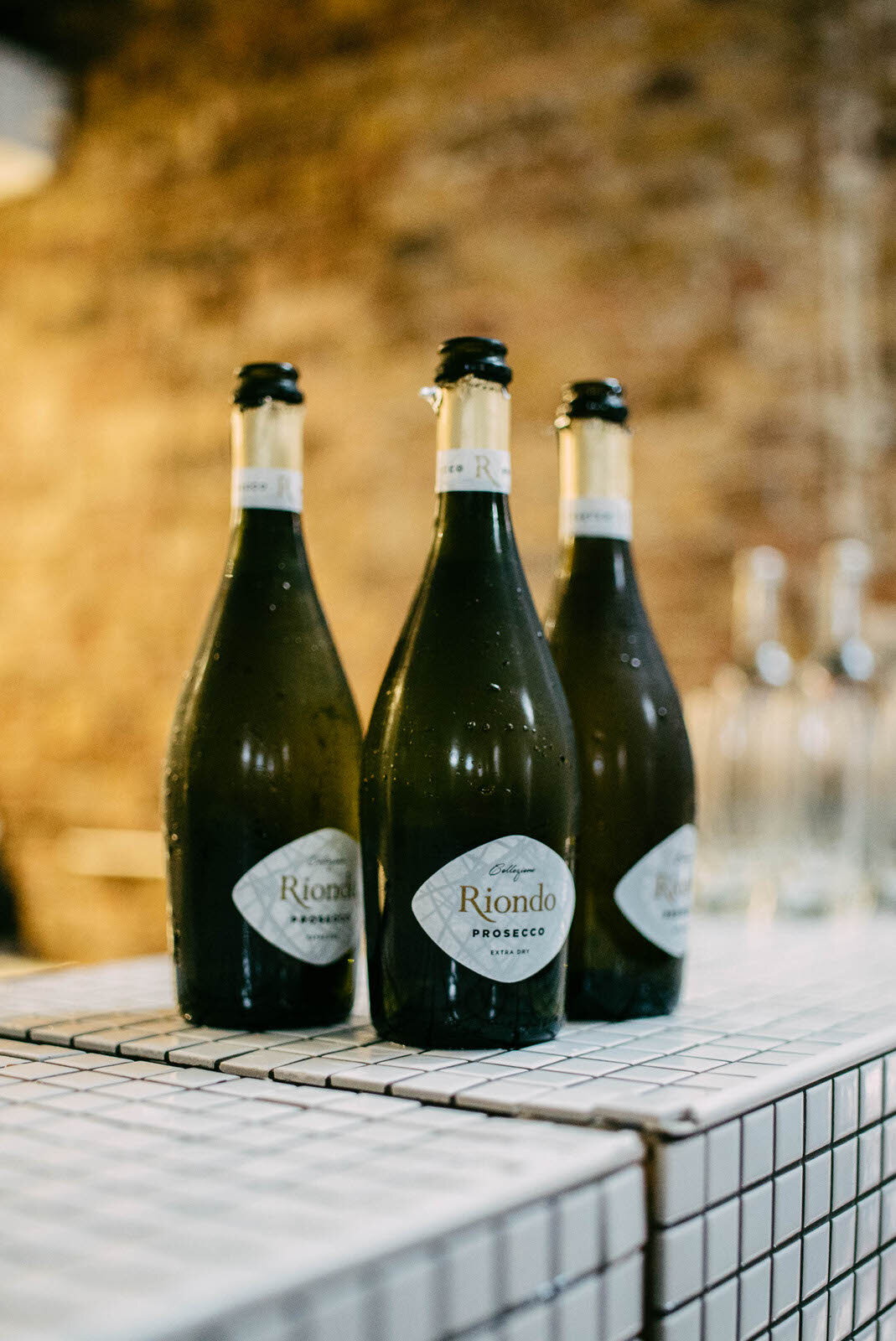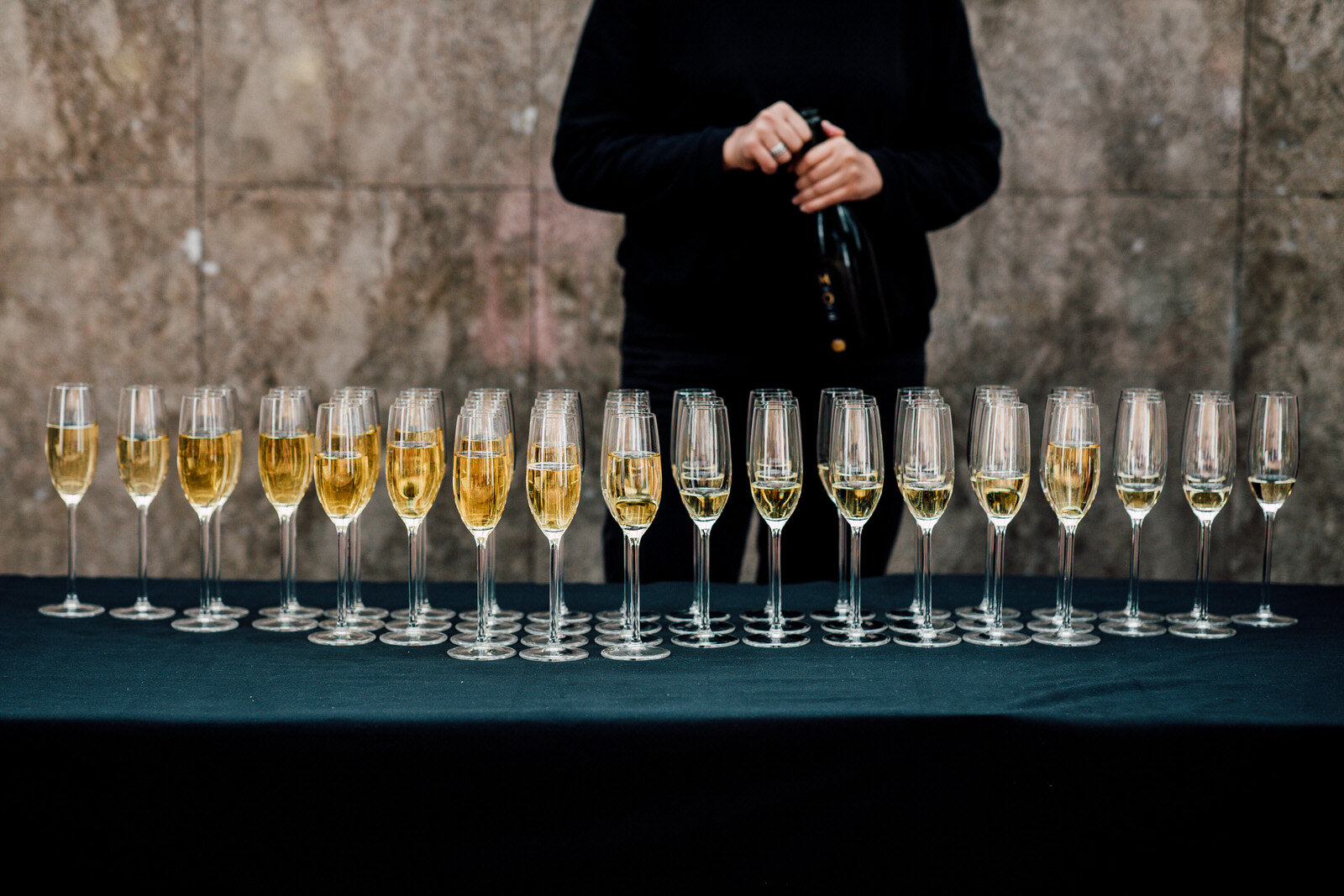The ceremony is over, the nerves have settled, the deed is done - it’s time to celebrate! For most couples this means cracking open something fizzy, a delicious and refreshing way to proclaim any marriage. But where do you start in selecting your celebratory bubbles, and what’s the difference between them all anyway?
Champagne, Prosecco, Cava, Sekt and Cremant, amongst others, are all styles of sparkling wine. They are made using different methods and grapes according to the style, and, notably, will have different price points according to prestige and reputation. Champagne is, of course, associated with ceremony and celebration but can also be the most expensive option and won’t suit every budget.
Champagne styles for your wedding
If you’ve decided to splash out on ‘the real deal’ for your guests, how do you go about selecting the right wine for the occasion? You’ll no doubt be familiar with the branded houses - Taittinger, Veuve Clicquot, Laurent Perrier, Bollinger and so forth. You may even have an idea of your favourite amongst these and generally you’ll find that their house NV (non vintage) blends are designed to please - easy going, refreshing and nicely balanced. Be aware of the sweetness levels of your wine. Most guests will prefer a dry style, especially before food. Champagne labelled Brut will have a maximium sugar level of 12 grams per litre (with Extra Brut and Brut Nature guaranteeing lower levels). Demi-sec will indicate a semi-sweet style (32 - 50 g/l) that you may find to be more suitable for after dinner.
The three main grape varieties used in Champagne are Chardonnay, Pinot Noir and Meunier. Those with a higher proportion of Chardonnay (Blanc de Blanc will be 100% Chardonnay) tend to be a lighter, more citrus led style; those dominated by Pinot Noir (Blanc de Noirs are 100% PN) are fuller bodied with red fruit; and Meunier driven wines tend to be fruit forward.
Branded or Grower Champagne?
The big Champagne houses we’ve all heard of have come to dominate the market. Sponsorship of huge sporting events, an association with decadance and glamour as well as good accesibility means they’re an easy choice. However, buyer beware, they come at a price which may reflect consistency but not always quality. ‘Grower Champagnes’ produced by the estate that owns the vineyard (the grand marcs often buy in their fruit from across the region) and are indicated by RM on the label. They tend to be more artisan and expressive in style. For wine geeks they represent an opportunity for food matching, but if you’re looking for an easy going reception drink you’d be wise to taste these wines ahead of committing to several cases. That said, they can also provide some of the best value in Champagne. When Moet & Chandon sign an exclusive deal with the Grand Prix, that money needs to come from somewhere, right?
Photo courtesy of Katherine Needles
Prosecco - the popular choice
The Prosecco boom started around 2011 with sales worldwide increasing 10 fold over the last decade. British consumption accounts for a whopping 30% of all Prosecco produced (in Italy, ironically, its popularity is arguably in decline with sales dropping 5% last year). As an easy going, refreshing and, crucially, affordable sparkling wine, Prosecco’s popularity extends way beyond wedding receptions. In profile Prosecco tends towards crisp green fruit, refreshing acidity and often a little more residual sugar (although different levels of sweetness are available). This rush to market has unfortunately meant that there are many inferior examples available. The growth of the “bottomless Prosecco brunch” has been fuelled by mass produced wine to wash down breakfast.
What’s the difference between Prosecco & Champagne?
The differences between Prosecco and Champagne are many (region and grape varieties are key) but fundamentally it’s the difference in production method that gives the two styles of fizz. In a nutshell, Champagne is produced using the Traditional Method (where the 2nd fermentation producing the bubbles takes place in bottle, the wine then being left on the dead yeast cells before disgorgement) and Prosecco is produced using the Tank Method (where the 2nd fermentation takes place in tank, followed by filtration of the dead yeast). Essentially it is this difference that gives Champagne it’s toasty, sometimes bready and complex characteristics as well as meaning that production of Prosecco is cheaper.
Photo courtesy of Amy Sanders Photography
Cava, Cremant and other ‘traditional method’ sparkling wines
Many other sparkling wines around the world are produced using the Traditional Method employed in Champagne. Most popular amongst these is Cava - the Spanish sparkling wine. Whilst Cava may have lost the popularity race with Prosecco to provide an economical alternative to Champagne in the UK, it nonetheless remains as a clear alternative for budget conscious couples. Just like Prosecco, there are numerous cheap (and bad) examples on the market - the supermarket push to sell Cava at rock bottom prices hasn’t helped its image - but take a small step up in price to explore delicious bottles often at less than half the price of Champagne.
Cremant is a style of sparkling wine produced in various regions of France - always using the traditional method but with grapes and ageing laws varying by region. Method Cap Classique is the name given to South African sparkling wines made in the Champagne method. Most of these wines are produced using premium fruit and the best can hold their own against more prestigious regions. And we need to mention the growing production of fabulous English Sparkling Wine too, again, made using the traditional method. ESW is growing in popularity for weddings although often the price tag isn’t far from Champagne.
Photo courtesy of Gingerbeard Weddings
Alternatives to Champagne for your wedding
At The Wedding Arrangers we believe that every wedding should be unique. Your wedding should reflect your style as a couple, creating a celebration like no other. If you want to break away from the conventions of traying out glasses of Champagne to your reception guests, we’d be over the moon to explore alternatives with you. Here are some of our ideas:-
Cider is wine. Well. Not ALL cider is wine, but real, 100% fruit cider is being classed as a product more in line with wine by a growing movement of connoisseurs. Available in a variety of different flavour profiles, incredibly refreshing, food friendly and served in Champagne flutes, why not kick off your celebration with cider?
Moscato d’Asti for your after dinner toasts. Made in the Asti method (partial fermentation of fruit and trapping CO2 to create bubbles), this wine is sweet, lightly sparkling and low in alcohol. Delicious, palate cleansing wine that won’t knock your guests out ahead of an evening of dancing.
Sparkling Tea - an elegant, refreshing alternative for your tee-total guests and those who want to manage their drinking.
Pet Nat or Pétillant-Naturel is a natural style of sparkling wine made using the méthode ancestrale, which actually pre-dates the traditional method used for Champagne. Like with the Asti method, the fermentation is stopped early and CO2 is trapped in the wine. As with grower Champagne, these may be an acquired taste and you’d be wise to try before you buy.
Mixed drinks and sparkling cocktails - from Bellinis to Mimosas, Aperol Spritz to Pimms Royale (with Champagne instead of lemonade - yum!) - think about the fun ways to involve fizz in other welcome drinks.
Bars from The Wedding Arrangers
Whether you are working with The Wedding Arrangers for your planning and coordination or not, we’d be pleased to help out with your wedding bar. Our stand alone bar service London Wedding Bars is available throughout London and the home counties. If your wedding is taking place in a venue where you can provide your own drinks, get in touch today to discuss our bar options.
Photo courtesy of Christine Wehrmeier
Food, Music, Booze
We’re excited to have tables booked at the Two Tribes brewery Camp Fire sessions - with music curated by Pete Herbert & Leo Zero, guest chefs including Ramael Scully and beers from the brewery itself, this just about ticks all of our boxes!





